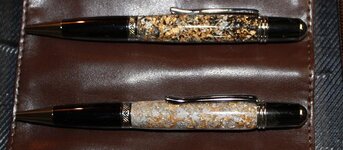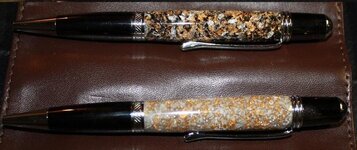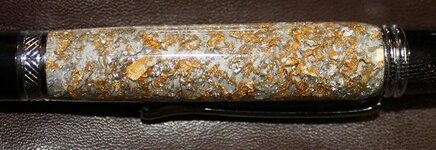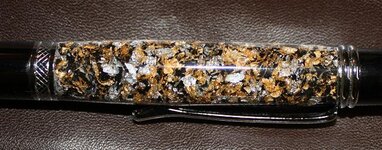Fibonacci
Member
DurocShark sells gold and silver flake blanks through ExoticBlanks. I asked him about the possibility of a mixed blank, and he sent me a pair to do a review on. He sent one that was cast under pressure and one that was not.
I apologize for the delay, but I sprained my finger working on a pen and had to take a break for a week or so. At the time, the doctor thought it was broken, but when the swelling went down, the pain went away, and the "break" in the bone stayed, they decided it was a sprain.
Anyway, to the review:
No Pressure:
I turned the one cast without pressure first. I used a skew for the whole thing, stopping to hone it every couple of minutes.
It looks beautiful as a blank. It drill very nicely, cuts with hand tools fine. I opted to reverse paint this one silver to provide an accentuate the silver flake.
It turned very easily, but chattered a bit. When I would stop and inspect it, it would have little pits on the surface that exposed small pieces of flake. I did not notice whether they were primarily gold or primarily silver. As a side note, these pits were on the scale of .5 mm pencil lead and about as deep. They seemed to occur at points where only a tiny piece of resin was left on the surface.
Trying to eliminate those, I stopped cutting about 1.5 mm larger than nominal and wet sanded it the rest of the way with 600 grit paper. This smoothed out the surface reasonably well, but I still had a few micropits. I finished it with MM and plastic polish like I would any other synthetic. When completed, the main surface took a nice shine, but still had some pitting. The pits are small enough that you really have to look for them, but you can feel them with a fingertip if you catch it just right. One should be able to eliminate them with a CA finish, if one cared.
When I went to assemble it, I discovered that I had a crack about 3/16" long starting at one end, following a piece of silver flake. I wicked thin CA into it with a razor blade and it completely disappeared. After re-polishing that section, I finished assembly and was very favorably impressed with it. The silver paint made the silver flake hard to make out, so the gold looked kind of out of place.
Pressure:
I turned the one cast under pressure next. This one, I painted black to try and make both kinds of flake stand out against the background.
This one drilled and glued fine. When I turned it, it felt much more smooth than the previous blank, but I got a handful of chips off of it. I would feel a little vibration in the skew and see a bright spot. When I stopped, a whole piece of flake would be exposed. These chips were more on the scale of 1/8" - 3/16" across and less than 1/16 deep. I wet sanded the last 1/16" or so to see if they were voids or just tool catches. I concluded that they were tool catches, therefore likely a technique problem, not a blank issue.
I also managed to crack this one from both ends, but the thin CA trick worked flawlessly again. I did the same MM and plastic polish on this one and got excellent results. There was no apparent pitting or surface imperfections.
Thoughts:
These banks are VERY transparent. It makes sense if you think about it. It is flakes suspended in resin, so when it is turned to pen thickness, a significant percentage of what you see is the paint on the inside of the tube. That said, I think that is what makes it work.
Looking at them online, I could not decide if they would look elegant or garish. In this configuration, I think it is quite elegant. I suspect that if you took a solid gold one and back painted it gold with gold hardware, then it would be garish. Same with a solid silver one. Using an accent to make the flakes themselves be the focus works well.
As transparent as they are, I think you might be able to put a decal on your tube and have it visible through the blank when it is done. A carefully selected decal could look extremely slick, but you would have to be very careful to get a solid glue layer to make it work.
As far as the pressure cast vs the non-pressure cast is concerned, either one is great. My personal preference is for the non-pressure cast. It had the chatter I described, but it felt more stable and easier to polish. The pitting would go away with a single coat of thin CA if it was a concern, but only one of the people I have shown it to even noticed. The pressure cast blank shed long, wide ribbons of resin as I turned it, where the non-pressure one had more thin, short ribbons. I personally prefer the short ones because they don't wrap up on the centers and make it hard to see the edges of the blank.
If the price were different between the two, I would buy the cheaper ones. If they were the same I would buy the ones cast without pressure for feel and because it comes in square blanks.
I apologize for the delay, but I sprained my finger working on a pen and had to take a break for a week or so. At the time, the doctor thought it was broken, but when the swelling went down, the pain went away, and the "break" in the bone stayed, they decided it was a sprain.
Anyway, to the review:
No Pressure:
I turned the one cast without pressure first. I used a skew for the whole thing, stopping to hone it every couple of minutes.
It looks beautiful as a blank. It drill very nicely, cuts with hand tools fine. I opted to reverse paint this one silver to provide an accentuate the silver flake.
It turned very easily, but chattered a bit. When I would stop and inspect it, it would have little pits on the surface that exposed small pieces of flake. I did not notice whether they were primarily gold or primarily silver. As a side note, these pits were on the scale of .5 mm pencil lead and about as deep. They seemed to occur at points where only a tiny piece of resin was left on the surface.
Trying to eliminate those, I stopped cutting about 1.5 mm larger than nominal and wet sanded it the rest of the way with 600 grit paper. This smoothed out the surface reasonably well, but I still had a few micropits. I finished it with MM and plastic polish like I would any other synthetic. When completed, the main surface took a nice shine, but still had some pitting. The pits are small enough that you really have to look for them, but you can feel them with a fingertip if you catch it just right. One should be able to eliminate them with a CA finish, if one cared.
When I went to assemble it, I discovered that I had a crack about 3/16" long starting at one end, following a piece of silver flake. I wicked thin CA into it with a razor blade and it completely disappeared. After re-polishing that section, I finished assembly and was very favorably impressed with it. The silver paint made the silver flake hard to make out, so the gold looked kind of out of place.
Pressure:
I turned the one cast under pressure next. This one, I painted black to try and make both kinds of flake stand out against the background.
This one drilled and glued fine. When I turned it, it felt much more smooth than the previous blank, but I got a handful of chips off of it. I would feel a little vibration in the skew and see a bright spot. When I stopped, a whole piece of flake would be exposed. These chips were more on the scale of 1/8" - 3/16" across and less than 1/16 deep. I wet sanded the last 1/16" or so to see if they were voids or just tool catches. I concluded that they were tool catches, therefore likely a technique problem, not a blank issue.
I also managed to crack this one from both ends, but the thin CA trick worked flawlessly again. I did the same MM and plastic polish on this one and got excellent results. There was no apparent pitting or surface imperfections.
Thoughts:
These banks are VERY transparent. It makes sense if you think about it. It is flakes suspended in resin, so when it is turned to pen thickness, a significant percentage of what you see is the paint on the inside of the tube. That said, I think that is what makes it work.
Looking at them online, I could not decide if they would look elegant or garish. In this configuration, I think it is quite elegant. I suspect that if you took a solid gold one and back painted it gold with gold hardware, then it would be garish. Same with a solid silver one. Using an accent to make the flakes themselves be the focus works well.
As transparent as they are, I think you might be able to put a decal on your tube and have it visible through the blank when it is done. A carefully selected decal could look extremely slick, but you would have to be very careful to get a solid glue layer to make it work.
As far as the pressure cast vs the non-pressure cast is concerned, either one is great. My personal preference is for the non-pressure cast. It had the chatter I described, but it felt more stable and easier to polish. The pitting would go away with a single coat of thin CA if it was a concern, but only one of the people I have shown it to even noticed. The pressure cast blank shed long, wide ribbons of resin as I turned it, where the non-pressure one had more thin, short ribbons. I personally prefer the short ones because they don't wrap up on the centers and make it hard to see the edges of the blank.
If the price were different between the two, I would buy the cheaper ones. If they were the same I would buy the ones cast without pressure for feel and because it comes in square blanks.




